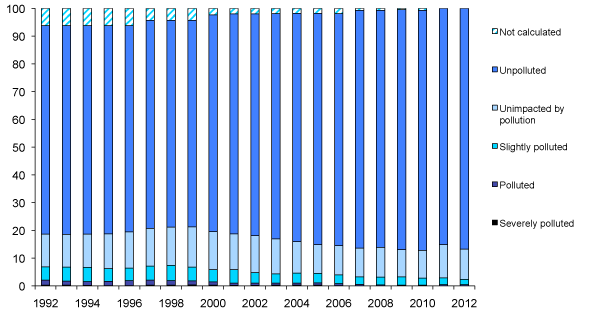Key Scottish Environment Statistics 2013
This publication aims to provide an easily accessible reference document which offers information on a wide range of environmental topics. It covers key datasets on the state of the environment in Scotland, with an emphasis on the trends over time wherever possible. The data are supplemented by text providing brief background information on environmental impacts, relevant legislation and performance against national and international targets.
This document is part of a collection
River Water QualityR: 1992-2012
Distribution of river water quality, percentage of river length within each band

Low standards of river water quality may threaten the aquatic environment, drinking water quality and recreational water use. Sewage, industry, urban development and agriculture are some of the factors that may affect river water quality.
The Scottish Environment Protection Agency (SEPA) has established an indicator of river water quality based on a network of sites covering 253 water bodies (rivers or sections of rivers), which account for approximately 10% of all water bodies. The indicator is based on a consistent set of five water quality parameters which are sensitive to organic pollution, nutrients and toxic substances and provide a measure of species diversity. Each of the parameters is assessed over a rolling 3 year period and the results weighted by river length. The assessment is against the standards provided for each parameter in the Water Framework Directive classification.8
In this indicator, river water quality is classified as unpolluted, unimpacted by pollution, slightly polluted, polluted, or severely polluted. Between 1992 and 2012, the proportion of river length for which river quality could not be calculated fell from 6.2% to zero. Most of these water bodies were subsequently classed as unpolluted or unimpacted by pollution.
Between 1992 and 2012, the proportion of river length that was classed as slightly polluted, polluted or severely polluted in Scotland rose from 6.8% in 1992, to 7.4% in 1998, before falling to 2.3% in 2012. The main drivers of slightly polluted, polluted and severely polluted rivers are inputs of nutrients, leading to degraded biological and nutrient quality. The proportion of river length classed as unpolluted rose from 85.7% in 2007 to 86.5% in 2010. After falling to 85.2% in 2011 the proportion then rose again to 86.8% in 2012. The length of river classed as unimpacted by pollution fell from 12% in 2011 to 10.9% in 2012.
Contact
Email: Callum Neil
There is a problem
Thanks for your feedback